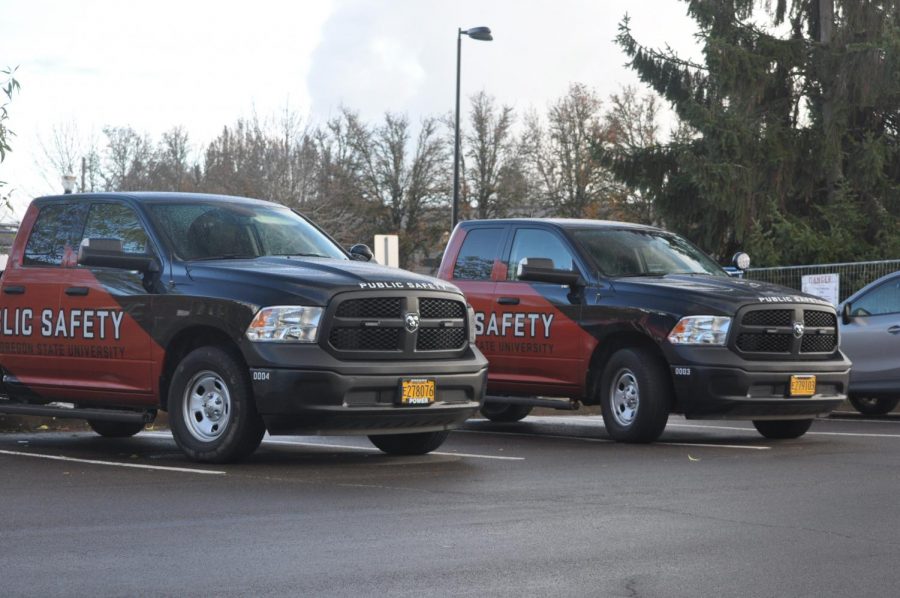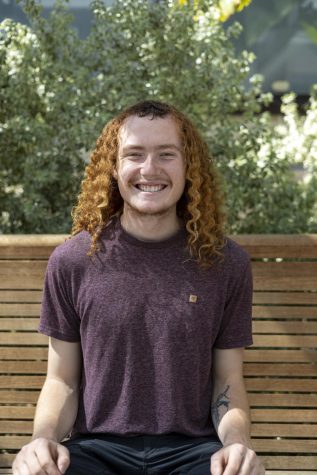Concerns about structure, ethics of campus security raised by OSU students
Oregon State University’s Department of Public Safety includes armed police alongside public safety security officers
January 3, 2022
Oregon State University has had its own police department since January 2021, but some students are against its presence on campus due to ethical and racial concerns.
In 2019, Genesis Hansen, a fourth-year OSU English and philosophy double major and person of color, was arrested by Oregon State Police in a controversial off-campus incident on charges of interfering with an OSP officer by refusing to show identification and resisting arrest after being pulled over while bicycling.
Prior to this incident, OSU had contracted with OSP to provide law enforcement services in Corvallis, Ore. but there had already been a push from different student groups at OSU to remove OSP from the university campus. This incident involving Hansen strengthened those calls to disarm OSU.
OSP ended its contract with OSU days after this incident, citing staffing issues. OSU then decided to create its own police force, which falls under the broader umbrella of the Public Safety Department and took over on Jan. 1, 2021.
According to OSU”s public safety website, “In 2013, the Oregon Legislature adopted legislation enabling Oregon’s public universities with governing boards to choose independently to operate their own licensed law enforcement department.”
In addition to dispatchers, emergency management and the clery team included in OSU’s Department of Public Safety are two types of officers: non-sworn public safety officers and sworn police officers of the OSU police department.
According to Lieutenant David Sweeney of OSUPD, PSOs are security officers responsible for public safety at OSU. Sweeney said PSOs typically respond to less dangerous tasks such as building unlocks, jumpstarts and bicycle incidents.
The armed OSUPD, however, responds to events where a higher level of danger might be present, according to Sweeney. OSU police officers also have the power of arrest.
Sweeney said PSOs on OSU’s campus drive the large trucks that are often seen on campus, which are valuable because they can pick up lost, stolen or abandoned bicycles. On the other hand, Sweeney said OSUPD drives Ford Explorers, or SUVs. The OSUPD vehicles are orange and white and say “Police – Oregon State University” on the side.
About five months after OSP ended its contract with OSU, the COVID-19 pandemic closed schools down and many students suddenly had more things to worry about, such as money, moving home and online classes.
“I heard that there was some backlash to us having our own police system,” said Shaurya Gaur, a third-year computer science major at OSU. “I was only on campus six months before [COVID-19] hit, it didn’t seem so much different… I feel like one thing that I never saw was an email or an announcement, like here is our new public safety strategy and how it works.”
Gaur said OSU sends out emails from the Office of the President and other leadership all the time in order to update students about the pandemic or sports events, but claims there was no real effort to educate the
OSU community on new public safety measures on campus.
“I think that it’s intentional [that students don’t know], and I think a lot of students—it’s not their fault for not caring about a lot of these issues, because you come to OSU and you move out of your house, you might have to be working yourself through school, or just taking on so many responsibilities,” said Jo O’Harrow, a fourth-year mathematics major at OSU. “You are so busy you don’t have time to learn about this really ugly and nuanced history.”
O’Harrow said the COVID-19 pandemic made it easier for the school to not educate students on the new police department. Even now that most students have returned to campus, they are focusing on readjusting to university in the middle of the COVID-19 pandemic.
According to Jason J. Dorsette, President of the Linn and Benton counties’ National Association for the Advancement of Colored People branch, when the U.S. abolished slavery in 1865, they created what we know today as the system of policing.
“I will say, at OSU, the public safety department is conscious, wants to do better and is going against an international narrative that all cops are bad,” Dorsette said. “While I appreciate the training and work [on police departments], we need to reckon with the history and ask why we are having the same conversations. There is reckoning, and we have to get better, but we are well on our way at Oregon State.”
After George Floyd, a Black man, was murdered by former police officer Derek Chauvin in Minnesota in 2020, Sweeney said the police were given another opportunity to be responsive to the kind of policing the community wants.
“In order to be effective, police departments have to be part of the community, not just an occupying force that comes in and ‘commits law enforcement’ without input from the community,” Sweeney said.
According to Gaur, police are primarily trained with weapons and to see the individuals they are supposed to protect as preemptive threats.
“That’s not really great for a lot of scenarios,” Gaur said. “Defunding the police is not completely destroying police but taking duties off them… mental health-related visits, addiction stuff, parking tickets—there is a lot of stuff you don’t need a gun to do… Armed officers are really only for violent crimes.”
Last spring term, Dorsette said he and two colleagues were invited by the then-new OSU Police Chief Sharon Anderson to facilitate a training on the history of policing, specifically illuminating how policing across the state of Oregon continues to affect Black, Indigenous and other people of color every day.
“It was uncomfortable for me as a Black person to facilitate and [for them] as officers to hear,” Dorsette said. “This training I was able to do was intensive, week-long, three-hours-a-day training. After each session, we engaged in a reflective activity. . . I asked officers to tell me how they felt, from shock to disbelief, to guilt, to crying—all of it.”
Dorsette said he believes this new OSU public safety department is doing better and appears to be holding each other accountable for their actions. Dorsette also said it is imperative that police departments all around the state of Oregon reckon with its history and ask, “Why are we having the same conversations today in 2021?”
According to O’Harrow, no one can be a good cop because the system is fundamentally bad. They said some small improvements within the existing system are better than none, but the system is still inherently racist.
“Step one is realizing there is a problem, and educating yourself on the problem, then step two is making the changes and solving it,” Gaur said.


















































































![Newspaper clipping from February 25, 1970 in the Daily Barometer showing an article written by Bob Allen, past Barometer Editor. This article was written to spotlight both the student body’s lack of participation with student government at the time in conjunction with their class representatives response. [It’s important to note ASOSU was not structured identically to today’s standards, likely having a president on behalf of each class work together as one entity as opposed to one president representing all classes.]](https://dailybaro.orangemedianetwork.com/wp-content/uploads/2025/03/Screenshot-2025-03-12-1.00.42-PM-e1741811160853.png)

























